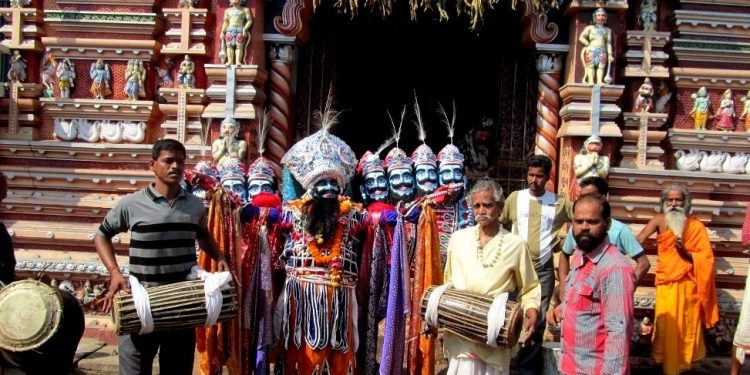In Odisha, the Jagannath Temple has been a centre of learning, humanitarian values, culture and artistic excellence. Lives of people of Odisha have been so inextricably inter-woven with Lord Jagannath that it is not possible for them to hold a separate identity independent of their God.
Mayadhar Mansingh, an eminent scholar, sums up in his Odia Sahityara Itihasa that, “Sri Jagannath occupies the central place and indeed is the soul of socio-religious life, culture and tradition of Odisha.”
In local language ‘Sahi’ means a particular area or locality. The antiquity of Sahis in Puri dates back to 1230 AD.
There were seven very old Sahis at Puri, on both sides of the Grand Road (Badadanda), which were virtually established around the Jagannath Temple. Harachandi Sahi on the west, Bali Sahi on the south, Dolamandapa Sahi on the east, Markandeswara Sahi on the north and so on.
In initial days, Puri town comprised seven Sahis, namely Bali Sahi, Kundheibenta Sahi, Dolamandapa Sahi, Harachandi Sahi, Goudabada Sahi, Markandeswara Sahi and Kalikadevi Sahi.
Earlier, these seven Sahis had 42 lanes or streets. However, Matimandapa Sahi is also regarded by some as the eighth Sahi of Puri town. Later on, some lanes or streets of Sahis, out of the above, came to be known as new Sahis.
Chudanga Sahi, Baseli Sahi, Swargadwar Sahi, Mochi Sahi subsequently came up. In 1868 AD, Sahis of Puri town had 6,304 households with about 30,000 population. Now, the town has spread in three directions and according to 2011 census, the population of Puri was nearly 2.01 lakh.
Lord Jagannath being the presiding deity of the ‘Sankha Kshetra’, the culture of Sahis in Puri virtually means Jagannath culture and the religion of Sahi people is synonymous with Jagannath Dharma.
The people of Sahis in Puri treat Lord Jagannath as a human entity and the Lord is accepted as head of their families. They participate in all functions of Lord Jagannath in the temple as well as observe those functions in their own households.
In all social functions like marriages and thread ceremonies, the Lord is first invited. Sebayatas (servitors) are known to be the oldest residents of Puri, who live in these Sahis. The traditional culture of Puri town is reflected in the lifestyle of Sahi residents, which is unique.
At the consecration of Grand Temple (Badadeula) by Anangabhima Dev-III, elite Brahmin servitors were brought from Kanyakubja or Ujjain. The king bestowed them with land and other endowments for living a dignified life dedicated to ritualistic responsibilities.
Each Sahi surrounding the Jagannath Temple has typical ‘Jagagharas’ (gymnasiums for men), which were set up by Gajapati kings of Odisha to protect the temple from external attack or foreign invasion which it faced 18 times so far. At that time, the colossal boundary wall Meghanada Pacheri, which surrounds the Jagannath Temple, was not built.
The Meghanada Pacheri was built by Gajapati Kapilendra Dev in 1448 AD in order to protect the temple. Besides military activities, the Jagagharas were centres of learning and culture. Mostly, the Jagannath Temple Sebayatas practise wrestling, body building and other forms of martial arts here.
A spring carnival called ‘Sahi Jata’ or the street play is a popular festival in Puri. It is one of the oldest festivals of the town and believed to have begun in 1230 AD. Sahi Jata is partly martial but its theme is religious. This fortnight-long festival begins on Rama Navami day and celebrates the birth of Lord Rama.
Sahi Jata is a kind of folk drama and the most attractive feature of it is the grand procession which starts from the narrow lanes of each Sahi and finally ends at the Grand Road of Puri.
In Sahi Jata, Chandan Jata and Makara Sankranti, the young men of these Jagagharas dress up like warriors and march ahead of other Sahis in procession. They exhibit Naga Dance, Medha Dance and Mala Khamba etc at the Jagannath Temple and the Gajapati King’s Palace.
Each Sahi is distinguished by its distinct flag and assigned a different event to play like birth of Lord Rama, killing of Mahisasura by Goddess Durga, Ravana lifting the Kailash mountain, capture of Sita by demon Ravana, battle between Parshuram and Lord Rama, battle between Rama and Ravana.
With changing times, Jagagharas have no such role to play these days. But, still every year they come out in procession with all pomp and ceremony to perpetuate the tradition. During above functions, young people of Jagagharas perform Medha Dance wearing masks of different Puranic deities and dance with religious fervour.






































